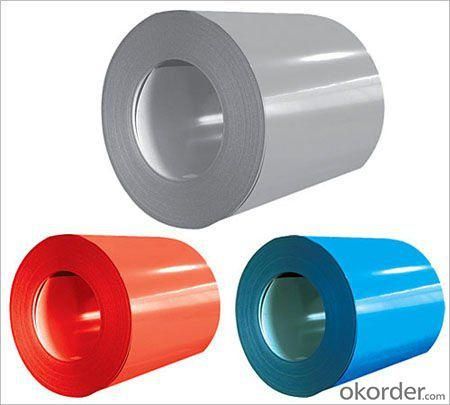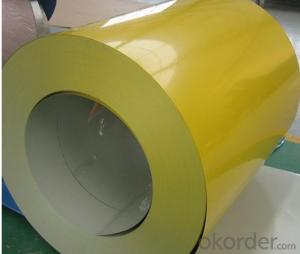Pre-Painted Galvanized Steel Sheet,Coil in Prime Quality Yellow Color
- Loading Port:
- Shanghai
- Payment Terms:
- TT OR LC
- Min Order Qty:
- 200 m.t.
- Supply Capability:
- 10000 m.t./month
OKorder Service Pledge
OKorder Financial Service
You Might Also Like
1. Pre-Painted Galvanized/Aluzinc Steel Coil Description:
With GI as base material, after pretreatment (degrease and chemical treatment ) and liquid dope with several layers of color, then after firing and cooling, finally the plate steel is called pre-painted galvanized (aluzinc) steel. Pre-painted galvanized steel is good capable of decoration, molding, corrosion resistance. It generally displays superior workability, durability and weather resistance.
2.Main Features of the Pre-Painted Galvanized/Aluzinc Steel Coil:
• Excellent process capability
• Smooth and flat surface
• Workability, durability
• Excellent heat resistance performance
• High strength
• Good formability
• Good visual effect
3.Pre-Painted Galvanized/Aluzinc Steel Coil Images

4.Pre-Painted Galvanized/Aluzinc Steel Coil Specification
Standard: AISI, ASTM, BS, DIN, GB, JIS
Grade: DX51D, DX52D
Thickness: 0.17-2.0mm
Brand Name: KMRLON
Model Number: coil
Type: Steel Coil
Technique: Cold Rolled
Surface Treatment: Coated
Application: Boiler Plate
Special Use: High-strength Steel Plate
Width: 20-1250mm
Length: customized
commoidty: pre-painted galvanized steel coil
Thickness: 0.13-4.0mm
width: 20-1250mm
zinc coating: 40-180g/m2
printing thickness: top side: 20+/-5 microns, back side: 5-7 microns
color: all RAL color
surface treatment: color coated
coil weight: 4-7 tons
coil ID: 508/610mm
packaging: standard seaworthy packing
5.FAQ of Pre-Painted Galvanized/Aluzinc Steel Coil
1. What’s the application of this product?
Roof, roof structure, surface sheet of balcony, frame of window, etc.
2. What’s the brand of the paint?
We use the best brand of all of the word—AKZO.
3. How about your company?
A world class manufacturer & supplier of castings forging in carbon steel and alloy steel,is one of the large-scale professional investment casting production bases in China,consisting of both casting foundry forging and machining factory. Annually more than 8000 tons Precision casting and forging parts are exported to markets in Europe,America and Japan. OEM casting and forging service available according to customer’s requirements.
4. How to guarantee the quality of the products?
We have established the international advanced quality management system,every link from raw material to final product we have strict quality test;We resolutely put an end to unqualified products flowing into the market. At the same time, we will provide necessary follow-up service assurance.
5. How long can we receive the product after purchase?
Usually within thirty working days after receiving buyer’s advance payment or LC. We will arrange the factory manufacturing as soon as possible. The cargo readiness usually takes 15-25 days, but the shipment will depend on the vessel situation.
- Q:I'm assuming that brass is flexible, expands and then bounces back to it's original shape. But if aluminum and steel expand and don't contract wouldn't they cause guns to jam more often for example?
- Some Blazer/CCI loaded ammo comes with aluminum casings, it is easy to tell because they have a very dull finish compared to the nickel. These cases are not safe to reload. There is also Wolf brand from Russia that has a steel casing, it looks laqured and it may or may not be able to be reloaded.
- Q:How are steel coils used in the manufacturing of pressure vessels?
- Steel coils are used in the manufacturing of pressure vessels as they are processed into flat sheets and then formed into the desired shape. These coils provide strength and durability to the pressure vessel, ensuring it can withstand high pressures and temperatures.
- Q:What is the strongest steel ever made.
- tungsten steel
- Q:Can steel coils be coated with polymer?
- Yes, steel coils can be coated with polymer.
- Q:How are steel coils secured during transportation?
- Steel coils are typically secured during transportation using steel strapping, banding, or wire rope. These materials are tightly wrapped around the coils and fastened to prevent any movement or shifting during transit. Additionally, wooden or steel blocking may be used to further secure the coils and prevent them from rolling.
- Q:How can I judge the quality of steel?
- The quality of the alloy can be very well be judged by its appearance and lustrous surface. The more luster on the surface the more refine will the steel be. To judge its tenacity and endurance, the alloy can be subjected to a series of procedures involving stress and shock. There are many more scientific methods of measuring the quality of the alloy such as texture measurement technique etc are also employed. In layman’s term the quality can be measured by the hardness of surface, brightness and smoothness of the surface and absence of any depressions or troughs.
- Q:How are steel coils used in the production of steel chains?
- Steel coils are used in the production of steel chains by being unwound and fed through a series of machines that shape, cut, and weld the steel into individual chain links. The steel coils provide a continuous and efficient source of raw material for the production process, ensuring consistent quality and strength in the final steel chains.
- Q:How do steel coils compare to aluminum coils?
- Steel coils and aluminum coils have several key differences that make them suitable for different applications. Firstly, steel coils are known for their strength and durability. They can withstand high temperatures and are less prone to damage compared to aluminum coils. This makes steel coils ideal for heavy-duty industrial applications that require robust materials, such as construction, automotive manufacturing, and oil and gas industries. Steel coils are also more resistant to corrosion, making them suitable for outdoor use in harsh environments. On the other hand, aluminum coils are lighter and have a higher strength-to-weight ratio compared to steel coils. This makes them perfect for industries where weight is a critical factor, such as aerospace and transportation. Aluminum coils are also more malleable, allowing for easier shaping and forming, which is advantageous in industries like packaging and consumer electronics. Moreover, aluminum coils have better thermal conductivity than steel coils, which makes them more efficient in heat transfer applications. This property is beneficial in industries like HVAC (heating, ventilation, and air conditioning) and refrigeration, where efficient heat exchange is crucial. In terms of cost, steel coils are generally more affordable compared to aluminum coils due to the lower cost of raw materials. However, aluminum coils can offer long-term cost savings as they require less maintenance and have a longer lifespan due to their resistance to corrosion. In conclusion, the choice between steel coils and aluminum coils depends on the specific requirements of the application. Steel coils are preferred for their strength, durability, and corrosion resistance, while aluminum coils excel in lightweight applications, heat transfer, and malleability.
- Q:How are steel coils used in the production of scaffolding?
- Steel coils are essential in the production of scaffolding as they serve as a primary raw material for manufacturing various components of scaffolding systems. These coils are typically made from high-quality steel and are used to produce tubes, pipes, and other structural elements that form the framework of scaffolding. The steel coils are first processed through a series of manufacturing operations, such as cutting, shaping, and welding, to transform them into the required dimensions and shapes for scaffolding components. These components can include vertical and horizontal tubes, diagonal braces, and base plates, among others. The tubes and pipes formed from steel coils are the main structural elements used to build the framework of the scaffolding. They are used to create the vertical uprights or standards, as well as the horizontal ledgers and transoms that connect them. These components provide the strength, stability, and load-bearing capacity required for workers to safely access and work at elevated heights. Additionally, steel coils are also used to manufacture diagonal braces, which are crucial for reinforcing the scaffolding structure. These braces are installed diagonally between the vertical standards and provide additional support and stability to prevent the scaffolding from swaying or collapsing. Base plates, another essential component of scaffolding, are also produced from steel coils. These plates are used as a foundation for the scaffolding structure, providing a solid and stable base to distribute the weight and load evenly. They are typically placed at the bottom of each vertical standard to ensure stability and prevent sinking or sliding. In summary, steel coils are a fundamental material used in the production of scaffolding. They are transformed into tubes, pipes, braces, and base plates, which form the framework and provide the necessary strength, stability, and load-bearing capacity required for safe and efficient scaffolding systems.
- Q:How are steel coils used in the production of prefabricated buildings?
- Steel coils are used in the production of prefabricated buildings as they are flattened and cut into specific sizes to serve as the structural framework. These coils are typically formed into beams, columns, and other essential components, which are then assembled and interconnected to create the building's frame. The strength and durability of steel make it an ideal material for prefabricated structures, ensuring the safety and stability of the buildings.
1. Manufacturer Overview |
|
|---|---|
| Location | |
| Year Established | |
| Annual Output Value | |
| Main Markets | |
| Company Certifications | |
2. Manufacturer Certificates |
|
|---|---|
| a) Certification Name | |
| Range | |
| Reference | |
| Validity Period | |
3. Manufacturer Capability |
|
|---|---|
| a)Trade Capacity | |
| Nearest Port | |
| Export Percentage | |
| No.of Employees in Trade Department | |
| Language Spoken: | |
| b)Factory Information | |
| Factory Size: | |
| No. of Production Lines | |
| Contract Manufacturing | |
| Product Price Range | |
Send your message to us
Pre-Painted Galvanized Steel Sheet,Coil in Prime Quality Yellow Color
- Loading Port:
- Shanghai
- Payment Terms:
- TT OR LC
- Min Order Qty:
- 200 m.t.
- Supply Capability:
- 10000 m.t./month
OKorder Service Pledge
OKorder Financial Service
Similar products
New products
Hot products
Related keywords





























